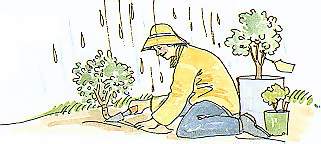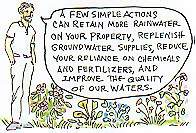|
 Landscaping
for a Healthy Sound Landscaping
for a Healthy Sound
 
From the
crest of the Cascades to the crest of the Olympics, from north
of Bellingham to south of Olympia, most of rain that falls on
our homes, lawns, and driveways eventually finds its way into
Puget Sound. What we do with and on our land directly affects
the quality of our waters.
Thoughtful
landscaping can change the volume, velocity, and timing of surface
runoff that flows from) our property. Decreased volume decreases
the danger of flooding, soil erosion, stream scouring, and the
delivery of excessive sediment to the Sound.
Getting
Started
 Planting
Trees, shrubs, and groundcover help reduce runoff,
minimize erosion, and enhance the appearance and value of your
property. Think about reducing your lawn and bare areas by increasing
the number and variety of shrubs and trees. Planting
Trees, shrubs, and groundcover help reduce runoff,
minimize erosion, and enhance the appearance and value of your
property. Think about reducing your lawn and bare areas by increasing
the number and variety of shrubs and trees.
If you
build a new home, leave as much of the original vegetation as
possible. Leaving the vegetation not only reduces runoff and
pollution but gives you a head-start on your final landscaping
and may increase the value of your home. It is particularly
important to leave a vegetation buffer along streambanks and
shorelines to avoid excessive runoff and erosion. Before you
start construction grading, get a copy of the Associated General
Contractors booklet, Waste Disposal and Erosion, and Sediment
Control Methods, by calling (206) 284-0061. Read the booklet
and share it with your builder.
Well planned
landscaping has other benefits too. Planting choices and locations
can reduce heating and cooling costs for your house by as much
as 30%. Trees, shrubs, and groundcover require less maintenance
than grass. They also require less fertilizer and fewer pesticides
than grass, reducing the chances of your yard adding polluting
runoff to the Sound. New shrubs and trees may also attract birds
and wildlife.

Appropriate
Plants for Puget Sound Landscapes Before you head for the nursery
or garden shop, consider the growing conditions around your
land. Fond of roses? Many varieties are susceptible to mildew
and fungus. To keep these roses growing, Northwest gardeners
often resort to heavy doses of pesticides.

How
To Choose…
 Fortunately,
nature has given us a hint. Over time, plants native to a particular
locale have adapted to local growing conditions. Plants that
grow naturally in the forests and open lands of the Puget Sound
basin are well suited to our patterns of rainfall and are bothered
less by common disease and insect problems than most plants
introduced from other areas. So, as a first step in plant selection,
look for native species. Fortunately,
nature has given us a hint. Over time, plants native to a particular
locale have adapted to local growing conditions. Plants that
grow naturally in the forests and open lands of the Puget Sound
basin are well suited to our patterns of rainfall and are bothered
less by common disease and insect problems than most plants
introduced from other areas. So, as a first step in plant selection,
look for native species.
Next, call
the Washington Toxics Coalition at (206) 632-1545 and request
Appropriate Plants for Northwest Landscapes. This fact sheet
lists and describes appropriate groundcovers, shrubs, and trees.
As a bonus, over three dozen disease resistant rhododendron
types are listed, along with a list of inappropriate plants
for Puget Sound landscapes. WSU Cooperative Extension has additional,
helpful publications. Finally, ask a competent, professional
nursery to help you select groundcovers, shrubs, and trees appropriate
for your yard and soil type.
Other garden
materials can influence runoff too. Avoid landscaping plastic
beneath decorative rock or bark. The plastic prevents water
from entering the soil. New, woven materials accomplish the
task of weed control while permitting water penetration. Similarly,
the chapter on erosion control discusses alternative, permeable
paving surfaces for paths, walks, patios, and driveways.
|




